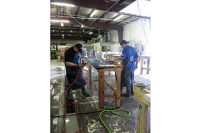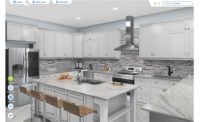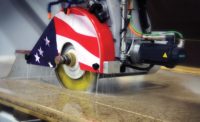“The customer actually came to us with the idea, and he kind of knew he wanted a scalloped edge,” explained Joe Blackmon of Myrtle Beach Granite and Marble dba Grassie Granite and Marble. “We worked back and forth on the spacing and the depth of it. We tried a couple of different versions of it, and we did some samples in 1/8-inch Luan plywood. Once the customer picked the shape of it, we cut a full-sized bartop in wood with the waterjet and brought it to his house to see exactly what it looked like before ever cutting anything in stone. Eventually, we used a waterjet to cut it in Blue Pearl granite, and then used a CNC router to do the edgework.”
Computerization was present through all steps of the process. “All of the drawing and waterjet programming was done in a software called Columbus made by ESAB, which is the same company that produces the waterjet machine,” Blackmon said. “All of the pieces were nested onto the slab to maximize the material usage. We had a digital layout that showed the bar top, counters, and even the granite corbels that support that bar top underneath. The software also programs the machine to do common line cuts with the waterjet, which greatly reduces cutting time.”
After being cut on the ESAB waterjet, the parts were finished on a CNC router from Bavelloni. “We used our standard diamond tooling,” Blackmon said. “We did a full bullnose edge profile. It still had the scallop shape, but it was fully rounded to a full bullnose. The pieces were good to go right from the CNC.”
A one-of-a-kind design
Creating an edge detail that had never been done before required some consideration by the fabricator. “[The most challenging aspect] was probably in the design phase of it — getting it to exactly what the customer wanted,” Blackmon said. “With a scalloped edge, once you get to the corner, you could be going into a ‘valley’ so it took a little bit of work to make it look good. A straight line was no problem, but the transition to inside and outside corners took some work.”
The nature of the design also required extra time for the equipment to run. “It just took a long time for the CNC to route that edge, just because there aren’t any straight lines,” he said. “Once you program the machine to run in non linear directions, there is a lot of acceleration and deceleration routines that any CNC machine goes through to smooth out the changes in direction to make it easier the drive system . I’d say it took seven to eight times as long as it would normally take to apply the full bullnose edgework, even with the automated processes, and it really isn’t something you could do by hand. All of those peaks and valleys have to perfectly spaced.”
While Blackmon didn’t predict that the scalloped look would become a trend, he did feel that the project serves as an example of what can be done using stoneworking technology. “We make all kinds of furniture, end tables and other odd things in stone, but we’ve never done something like that before,” he said. “I don’t know if there’s going to be a great deal of demand for it, but the customer in this case wanted something that would be unique that nobody else would have.”
Upon completion, the project was well received by the customer. “He loved it,” Blackmon said. “He actually came back and we did another piece behind the stove that went vertically up the wall. I think he’s going to do some other work with us as well.”










